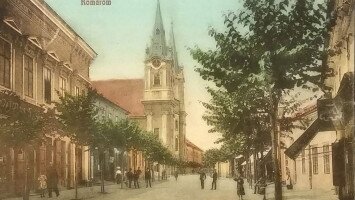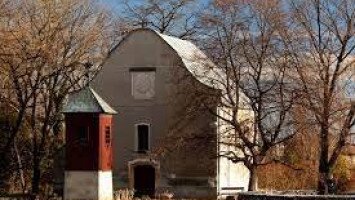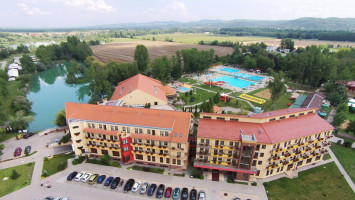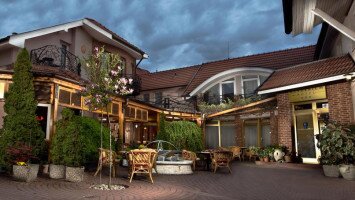
History of Patince
The village of Patince lies on the Danubian Lowland, in the lower section of the extended valley of the rivers Váh, Žitava, and Nitra, on the left bank of the Danube, 15 km from Komárno. The altitude of the old part of the village is 111 m. The area used to be the day of a huge swamp, from which slow rivers full of curves formed a huge lake during the floods. Only here and there did small islands emerge, created by sand accumulated on the sites of former troughs and shores. The composition of the upper layers of the soil also corresponds to this. The climate of the village is mild, the average annual temperature is + 10.5 C. Precipitation is low every year and they are irregular. They rarely reach 550mm in a year. A thermal spring was created from a borehole in 1950. The land of the area is formed by fertile clay, its area together with the Danube is 2849 cadastral jute, 1200 square reach. It has fifteen parts. Patince lies at the southernmost point of the Slovak Republic, at 47 ° 43´ 55´´ north latitude. There are well-known spa and a resort.
Prehistory, Antiquity
In the area of Chotín, Marcelová, and Virt, archaeologists have found the remains of continuous settlements from the Stone Age. Finds unearthed during earthworks in Urine prove that people lived here as early as prehistoric times. The glacial burial ground in the Patince area, a settlement from the Bronze Age in the Virt district, an older settlement between Radvaň nad Dunajom and the estuary of the Zittau point to the presence of cultures layered on the site of older settlements. The oldest finds are four stone planers which have Eneolithic origin. The Neolithic man sanded his harpoons with stone planers, shaped them, and adapted them to fish in the river. At the same time, these stone tools prove that there was a Neolithic fishing village in this area. Newer settlements, discovered in Patince, Iža, and Moča, were disturbed everywhere by the layered burial grounds of the northern Pannonian younger and middle Bronze Age. A Neolithic man discovered copper about 6000-7000 years ago and prepared his tools - similar to older stone ones - from copper. Copper melted along with tin and this alloy, bronze, was harder and more suitable for use. It was also easier to melt. Such settlements from the Copper and Bronze Ages were in Iža, Patince, and Moča. Archaeological finds from this area already give us a more accurate picture of the settlement: the climate, which was previously richer in precipitation and humid, has changed over time to dry. As a result of this process, tillage has spread here. Agriculture has fared better. In the Iron Age, development was associated with certain national communities. The countryside was inhabited by Scythians, Celts, and Illyrians. Celtic culture lasted in this area until 60 BC, then the Dacians appeared here, and the two ethnic groups merged. Nations that came later settled on the sites of previous nations. During the rule of Rome, there were important Danube fords, which connected the forts on the right side of the Danube (Limes) and watchtowers (castellum), standing on the left bank. The Roman presence after the Hun period was replaced by the Gepids and later by the Avars. (450 BC). These tribes formed around the 7th century with the predecessors of Croats and Serbs the Pannonian state, the Great Moravian Empire. Around the then water castles, Slavic tribes were grouped - Moravian Slavs, Pannonian Slavs, or Slovenian and Bulgarian Slavs, and a Slavic ethnic group was formed in this area. At the time of the Hungarian invasion, the inhabitants of these settlements were Slavs. At the cost of the fighting, the territory of today's Komárno fell into the hands of the Hungarians, we do not know exactly. We rely on the Anonymous Chronicle, the Túroci Chronicle, and the Chronicle of Simon of Kéza. According to foreign, mainly German sources, the Hungarians occupied this area in the period from 896 to 900.
According to Borovszky's monography, Patince was a master in 1268 and is recorded in the form of terra Poth as the property of the Komárno castle subject, from 1368 is a record of terre Poth and Polth, from 1444 record possessio Path, from 1485 Praedium Path. In 1396, they were the property of László Pathi Pozsár's wife, but they were launched in Turkish times. After 1559, new landowners appeared. The family of János Path and Illés Bank died by the sword, so the Hungarian palatine was donated to the village to István Szentiványi Babits. In 1616, the local landowner was Miklós Path and Márton Markházy, in 1634 again István Laly and István Mórocz. In 1655 Patác was given to Lukács Pozsár and in 1634 to György Csajágha on the basis of a palatine deed of donation, and in 1716 by Ferenc Gyulai as a royal deed of donation. However, intrigue persisted at the royal court and they shortened the life of many royal gifts. As a result, the number of feudal lords owning the village grew, and eventually, the property fell into the hands of the Pálffy family. According to Borovszky, "There were spas and hot springs in the village in Romanian times, they still give water." Elek Fényes writes in 1840 about Patince as: "Patince is a mayor, half an hour's walk from Iža, by the Danube, they have 237 Catholics, mostly tenants of land who grow very strong tobacco. There are 38 houses, each with 1 and ½ of the internal land, external land does not have. For each house, they pay according to temporary contracts 5 pengő forint, and they must work 12 days. The manure of the topsoil is 309 ½ yoke, 2,000 yoke meadows are in the wetland, they cannot be mowed every year, but they give an average of 5,000 meters of hay per year. There is also a 300-yoke pheasant, which belongs to Prince Antal Pálffy. ”In the past, the Patince was recorded as a settlement. There are also known lawsuits led by Mihály Pozsár, György Berencs and Jakab Pathi Gálffy for building a "váiss" on the river Serkel, which is a trap. Korlátkői Osvald brought them to court because of this. According to Matej Bel, the Danube washes the banks of the Iža, Patiniec, and the estuary of Zittau. It is also known that they can catch fish here near Komárno, but also anywhere. The countryside is rich in fish where the waters are calmer and deeper. "Matej Bel further writes that" Páth is a German settlement, the church of which was repaired by Count Ferenc Gyulai. It is bordered on the north by the localities of Kurtakesz and Marcelháza, on the east by the estates of Nedeczky, on which the settlement of Virtház lies. This property makes a well-known stream with healing water. Spring flows into the pond: it is white and its vapors are healing. The landowner had a bath building, where the water is heated by fire and used to bathe the limbs, weakened by a long illness. Because of this it is called German either Either, the name remained in the village, but the Hungarians at the time changed it to Path with their pronunciation. ”
Thúroczy writes about the Path family that its founder is Konrád of Aldenburg. A member of this family who came to the country at the time of Salamona (1063-1074) was called Henristus. The name Both was given to him because Emperor Conrad, András, and Salamon entrusted him with the role of envoy. The envoy is Bothe in German. This changed to Poth, later Path. At the request of his falconer Marczello Madari, King Louis I. removed his relatives from the Komárno castle serf and promoted them to the ranks of the country nobility for the release of certain lands in Patince. After 1546, the sons of Demeter Pathy are mentioned, to whom Miklós Pozsár, together with the sons of Kakasa, banned fishing in Zittau.
After the arrival of the Turks, Patince was launched in 1532 as a burnt village, they did not have to pay taxes. In 1549, according to the record of the Defterdár (Turkish tax collector), he had 5 residential houses, in 1556 only 8, and in 1576, only two desolate houses appear in the tax register. In 1576, Patince was repopulated, in 1698 had 20 farms, in 1699, there were already 34 houses in the village. After the expulsion of the Turks, the village was inhabited by Calvinists. This is also proved by the vessels of the Lord's Evening: the chalice and the tin plate, which are located in the Calvinist church in Radvaň nad Dunajom. There is an inscription on the plate that was donated to the Patina Church by István Czihary in 1618. The Church of Patina also included the Calvinist branch in Iža, about which a document preserved in the Bratislava archives writes as follows: "Izsa lelke Path", translated as "the soul of Iže is the Path". So there was a mother church in Patince. In 1674, the local Calvinist priest Tomai was imprisoned. Since then, he was represented only by the Levit's pastor, who probably in 1745 drove away. As a result, the Calvinist church in Patince disappeared and the villagers moved out. In the primitive archive of Esztergom there are data of canonical visitation from 1714, according to which the landowner of Patince is Komárno castle captain János Jakab Heibl. There were 24 non-slave lands in the village, but at the time of the visitation they were abandoned except for three, and only 30 inhabitants lived there. In 1731, the church was abandoned (it had "a broken door, birds were flying through broken windows"). There was a lowered altar in the sanctuary. In 1754, the ceiling was already sagging, the altar was no longer there. The village had 109 inhabitants at that time, in 1761 there were only 99 and they were of Catholic faith. They carried a lot of stones from the walls of the church, so it threatened to collapse. Ovid Faust, the former director of the Trnava Museum, found the following record of Patince in Chtelnice: "The Pálffy family brought 21 families to Patince in 1760, about 1 kilometer east of the old village, and built a new village. In 1776, they began the reconstruction of the original Romanesque church in the old village, which was in 1780 consecrated. The altarpiece was donated to the church together with the altar by Count Pálffy. According to experts, the painting, which probably comes from a family chapel, is a rare work of art. Unfortunately, the painter's name could not appear on the painting. The village belonged to Marcelová, the church to village Iža. ”
Peace with the Turks
At the lower end of the forest, at the estuary of Zittau, stood an old oak tree with a diameter of 80-100 cm. According to the oral presentation, it was under this oak in 1606 that the commissioners of Rudolf I, István Bocskai, and Sultan Ahmed signed the so-called Peace of Zittau. At that time, they agreed on the issues of taxes and territories, which remained under the Turkish administration. This peace was in addition to the so-called Vienna's peace act and lasted for twenty years.
An important road led along the left bank of the Danube, connecting Komárno, Vacov and Budapest. Patince did not get around the war. In the last act of the drama, under the command of General Grabbe, the left bank of the Váh was occupied by Tsarist Russian troops. The staff was based in Krátky Kesy (now Marcelová). The Cossacks ravaged the countryside. On the 2nd of July 1849, the new commander-in-chief of the Hungarian troops, Lázár Mészáros, moved to besieged Komárno. He tried to get to the castle by boat, but Haynau had just launched a new attack, so Mészáros had to turn about 8 km from the town near Patince and return.
Source: https: // www .obecpatince.sk /












